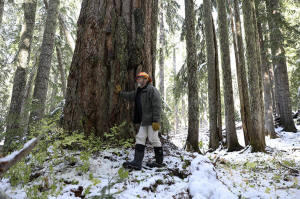Biden administration withdraws old-growth forest plan after getting
pushback from industry and GOP
 Send a link to a friend
Send a link to a friend
 [January 08, 2025]
By MATTHEW BROWN [January 08, 2025]
By MATTHEW BROWN
BILLINGS, Mont. (AP) — The Biden administration on Tuesday abruptly
dropped its nascent plan to protect old-growth forests after getting
pushback from Republicans and the timber industry.
The move was announced by U.S. Forest Service Chief Randy Moore in a
letter to forest supervisors.
It brings a sudden end to a yearslong process to craft a nationwide plan
that would better protect old trees that are increasingly threatened by
climate change. The effort had been supported by some conservationists
as one of the most significant forest preservation efforts in decades.
President Joe Biden launched the initiative with an executive order on
Earth Day in April 2022. The proposal went through extensive public
comment periods and internal analyses by government officials and was
due to be finalized any day.
The plan would have limited logging in old-growth forests, with
exceptions to allow logging in some old-growth areas to protect against
wildfires.

But those exceptions were not enough for the timber industry and
Republicans in Congress who bitterly opposed the administration’s
proposal. They said it wasn’t needed since many forested areas already
are protected. And they warned it could be devastating to logging
companies that rely on access to cheap timber on public lands.
GOP lawmakers introduced legislation while the administration’s plans
were still in the works to block them from going into effect.
Moore said in his letter that much was learned from the
first-of-its-kind effort to identify old-growth trees on public lands
across the nation. He also acknowledged criticism from those who said
the administration’s approach to old-growth forests was flawed since
they can vary greatly between different types of ecosystems.
“There is strong support for, and an expectation of us, to continue to
conserve these forests based on the best available scientific
information,” Moore wrote. “There was also feedback that there are
important place-based differences that we will need to understand in
order to conserve old-growth forests.”
Montana Republican U.S. Sen. Steve Daines in a statement called the
withdrawal of the old-growth plan a “victory for commonsense local
management of our forests.”
Most old-growth stands fell to logging as the nation developed. Yet
pockets of ancient trees remain, scattered across the U.S. including in
California, the Pacific Northwest and areas of the Rocky Mountains.
Larger expanses of old growth survive in Alaska, such as within the
Tongass National Forest.

[to top of second column]
|

Peter Beedlow, a scientist at the Environmental Protection Agency,
stands among a group of old-growth Noble fir trees in the Willamette
National Forest, Ore., Oct. 27, 2023. (AP Photo/Amanda Loman, File)

There’s wide consensus on the importance of preserving them — both
symbolically as marvels of nature, and more practically because
their trunks and branches store large amounts of carbon that can be
released when forests burn, adding to climate change.
Alex Craven, the forests campaign manager for the Sierra Club
conservation group, said there was a "scientific necessity and
public expectation” to protect old-growth and mature forests.
“Those two facts make formal old-growth protections a matter of
when, not if,” Craven wrote in an email.
Wildfires in recent years decimated blocks of old-growth forest in
states throughout the U.S. West and killed thousands of giant
sequoias.
Wildfires, insects and disease have been the main killers of
old-growth trees since 2000, accounting for almost 1,400 square
miles (3,600 square kilometers) of losses, according to government
research. Logging on federal lands cut down about 14 square miles
(36 square kilometers) of old-growth forest — and timber industry
representatives have said that figure shows further restrictions
aren’t needed.
Bill Imbergamo with the Federal Forest Resource Coalition, an
industry group, called the administration’s proposal “legally
dubious and ecologically flawed.”
“All this exercise showed was that older forests are widespread on
the national forest system. Most of these are already off limits to
timber harvest,” Imbergamo said. “Old growth forests are succumbing
to fire, insects, and disease, and they need management to make them
healthier and more resilient."
A White House spokesperson did not immediately respond to telephone
messages seeking comment.

The administration's plan faced a doubtful future if it had been
finalized. During the first term of President-elect Donald Trump,
federal officials sought to open up huge areas of West Coast forests
to potential logging.
Federal wildlife officials under Biden reversed the move in 2021.
They found that political appointees under Trump relied on faulty
science to justify drastically shrinking areas of protected forest
considered crucial habitats for the imperiled northern spotted owl.
The owl has been in decline for decades as old-growth forests were
cut in Oregon, Washington and California.
All contents © copyright 2024 Associated Press. All rights reserved |